 Read the peer reviews for this feature.
Read the peer reviews for this feature.
Download the graphs for this feature.
Changes are taking place in the way people travel. And although we can identify some contributory factors, it is too soon to predict how durable those trends will be. A levelling-off of average car miles per person until 2013 has been matched in 2013-14 by a 5.31% increase in rail passenger journeys, which have more than doubled since privatisation. There has also been a modest increase in cycling (12%) over the past ten years.
A downturn in car use began before the recession, and many reasons have been suggested: the end of the company car as a perk; fewer parking places; improved alternatives; having children later; health concerns encouraging active travel (cycling and walking).
But it is among the millennial generation (those born between the early 1980s and early 2000s) that the change is most pronounced, with the cost of learning to drive, high vehicle insurance costs, student debt, alternative consumer preferences, a propensity to live in urban areas and the importance attached to fitness among the reasons behind it.
Since 1992-94, the number of driving licence holders in the 17-20 and 21-29 age brackets has declined from 48% to 29% and 75% to 63% respectively. Indifference to the car as a status symbol may stem from economic reality, although a similar story can be found in affluent Switzerland, where only 59% of those aged 18-24 have a driving licence. There is also some evidence that those who learn to drive later tend to drive less.
The flipside is a much greater willingness to embrace multimodality, and to choose the optimum mode (or combination of them) for each journey. This is helped by the host of websites and apps providing unprecedented guidance and booking opportunities, in tune with the way younger generations think and live their lives.
Of course, railway travel has always been multimodal. But the trend emphasises the importance of the forgotten Holy Grail of rigorous integration - as exemplified by the SwissTravelSystem, not only in its dovetailed services, but the meticulously detailed travel plans on its website.
Payment systems also need to be developed to cater for multimodal journeys. Perhaps the most all-embracing is the Mobility Mixx card in the Netherlands, which can be used to pay for all public transport, taxis, car pool, bike and car rental, and Park & Ride tickets.
A combination of economic and social circumstances has encouraged these changes among young adults. But how can modal change be effected among the rest of us? The premise behind the question is naturally that any rational policy or credible climate-change mitigation measures must encourage greater use of benign and less-damaging modes of transport… and discourage the worst.
Habits inhibit rational choices, and are coloured by perceptions rather than facts. Deterioration in a chosen option or improvements in the alternatives may not be sufficient to break a habitual pattern, even when congestion makes a journey by car significantly longer than the public transport equivalent. This can go hand-in-hand with a tendency to over-estimate journey time by public transport, and under-estimate the time spent driving.
One of the most revealing (if unsurprising) findings of a number of transport studies is that one of the most likely moments to influence travel behaviour is a change in personal circumstances, whether it be moving home or place of work. Awareness of this opportunity to break a habit prompted the city of Salzburg to provide new residents with a comprehensive information package about its S-Bahn services, and a gift coupon for public transport tickets. It is currently being rolled out to other regions in Austria.
Habit-breaking initiatives
Among some groups, a leaning towards car use can reflect socially induced attitudes and an association of car with status - immigrants have been known to hire a car for a photograph of the family, to show they had ‘arrived’. As another put it: “I haven’t come from Pakistan to ride a bicycle.” However, immigrant households tend to use the car less than the indigenous average of that household type.
Such mindsets are a challenge, although there have been successful habit-breaking initiatives. The University of California offered a free 12-week public transport pass for all employees who handed in their parking pass for that period. After this trial period, the 381 participating employees were offered their parking passes back, or the opportunity to purchase public transport passes at half-price - 70% continued to use public transport, having familiarised themselves with routes and schedules and finding travelling by bus to be less stressful than driving.
Changing travel behaviour requires complementary policies of carrot and stick, ‘pull’ and ‘push’ mechanisms. The Happiness Research Institute in Copenhagen says “the challenge becomes inducing people to act in certain ways without forcing them to do so”, but there is plenty of evidence to suggest that a combination of push and pull measures (restrictive and enhancing interventions) are necessary to accelerate significant results. Broadly speaking, ‘pull’ mechanisms are in the hands of transport providers and ‘push’ in the domain of both central and local government, so understanding pull factors helps the railway industry focus both hard and soft investment.
The pull factors are the positive attributes attached to a mode, and there is no doubt that the quality of many of the pull factors on Britain’s trains and stations has improved significantly over the past two decades.
Research for the DfT identified seven categories of public transport ‘requirements’: affordability; accessibility/ease of use; comfort; environmental friendliness; frequency and reliability; safety and security; and (rather curiously lumped together) speed/seamlessness of journey. The most important are accessibility/ease of use and frequency/reliability, followed by the comfort/cleanliness levels of rolling stock and waiting areas.
To these might be added good WiFi provision and good pre- and in-trip information. High-quality, real-time service information was the highest rated attribute in Seattle, while the benefits of seamless interchanges and integrated ticketing were apparent in Haifa (Israel), where an 8% increase in trips followed the introduction of a zonal fare system. Fragmented ownership or operation need be no impediment to high-quality transfers and real-time information, as Singapore and Switzerland both demonstrate.
It is hopefully only a matter of time before the UK catches up with the rest of western Europe in the provision of bike hire schemes, London’s scheme being the exception rather than the rule.
Although rail operators do not have to be the provider, they have often taken the lead on the Continent. Eighty Swiss stations and 44 German stations offer bike and e-bike hire, while DB’s ‘Call a Bike’ flex programme in Munich, Cologne, Frankfurt and Karlsruhe allows cycles to be rented at the station and deposited at docking stations around the city. Since 2010, bikes can be unlocked and checked out using a smartphone app.
In Lyon JCDecaux has set up a bike-hire system with 340 stations and 3,000 bikes, with 52,000 registered users. Day or week-long tickets can be bought with a credit card without pre-registration.
For business travellers, the opportunity to work on trains is paramount, although surveys suggest some choose the car because of the privacy it offers. Are trains designed with a wide enough variety of accommodation? DB provides bookable meeting compartments on some trains, while Pendolinos on VR (Finland) have a working compartment for seven people or the option of hiring a whole coach.
Pull factors can also become negatives - if a passenger cannot depend on the virtues of punctuality, reliability and comfort, they may give up on rail if they have a choice.
Transport Focus surveys repeatedly show that reliability, punctuality and cleanliness have the greatest impact on satisfaction. Overall satisfaction with both trains and stations is high at 78% (spring 2015), but toilet facilities, delay management and value for money receive perennially low train scores. At stations, availability of seating, the choice of shops/eating and drinking facilities, and car parking regularly score the worst marks.
At St Pancras and King’s Cross, the policy of raising the standard of shops and places to eat has led both to become destinations in their own right, attracting local users. In contrast, current plans at another London terminus, aimed at maximising returns, look likely to lose the most interesting and upmarket retailers regardless of the perception and demographic of users.
Free public transport
Perhaps the most extreme pull measure is offering free public transport, such as the free use of buses for UK pensioners, for whom travel can be price-sensitive. However, the cost benefit payback of this measure has yet to be studied.
From November 2014, about 46% of the Slovak population became eligible for free train travel, with 103 new services to absorb the expected increase. But in Austin (Texas), free use of buses was ended at the request of existing users, because it attracted a new clientele that dissuaded existing and other potential passengers from using public transport.
Thus a permanent change of mode is more likely to be achieved through improved quality, rather than price reduction. That said, ‘Value for money’ constantly remains one of the lowest scores in Transport Focus surveys.
Disappointingly for environmentalists, a desire to save the planet by adopting greener travel barely registers in some surveys. The societal costs or externalities of more polluting modes do not sufficiently concern the overwhelming majority of people to make them change their behaviour and adopt more benign modes. The question some researchers have asked is whether this is due to indifference or ignorance, and how best each mental state should be addressed to effect change.
This is partly due to the way in which people trade off benefits and costs: individual vs societal; immediate vs deferred; and local vs global.
Because a higher weight is attached to immediate (rather than deferred) benefits, it is more productive to focus education and persuasion on present and local negatives - for example, traffic pollution and noise rather than climate change, even though the potential impact of the latter dwarfs the former.
There is the inevitable sense of feeling both more responsible for the local than the global and recognising the greater likelihood of ‘making a difference’. Yet the local environment suffered in the Netherlands following the introduction of catalytic converters - users of cars fitted with one tended to drive more, ignorant of the fact that they don’t work effectively until warmed up.
Research published by the DfT in 2011 (Public attitudes towards climate change and the impact of transport: 2010) found that 65% of respondents said they were willing to change their behaviours to help address environmental issues, although only 42% were willing to do this by using public transport (see graphs). Graduates appear to be more concerned about climate change, more willing to change their behaviour to limit it, and were significantly more likely to be willing to use public transport more (57% compared with 41%).
Recent travel behaviour research suggests that the dynamism in modal choice is higher than expected, presenting an opportunity for policy-makers and public transport operators to influence those willing to change their behaviour.
Enlightened companies have responded to the effects of stress brought on by congestion during commuting, recognising that it leads to increased absenteeism, reduced job satisfaction and decreased task motivation. They have bought into Smart Travel Plans to unfreeze habitual behaviour, and provided bike loans and facilities such as good changing rooms/showers.
The benefit for train operators of more active travel to stations is a reduction in the demand for car parking spaces. Virgin added 30 spaces at Penrith at a cost of £83,333 per space, which would take 19 years to recover through charges assuming every space was constantly occupied. The £2.5 million spent by Virgin could instead have transformed the town’s cycling network, producing far wider benefits and an obvious environmental gain.
“I can’t make a difference” is the sentiment behind the ‘dilemma of the common pool’, in which a behaviour makes sense from an individual point of view, but proves disastrous to society when repeated by a large number of individuals. The individual car user perceives their impact as minuscule in the context of millions of other users, and so has no incentive to reduce car travel.
Changing this attitude so that people take responsibility for their behaviour will always be a challenge, but there are principles behind persuasion that can help:
- Reciprocation: People respond better to favours than bribes. In Melbourne, an environmentally friendly (but unbranded) shopping bag was given away with a discount voucher for a whole shopping centre.
- Commitment and consistency: There is an innate desire to be consistent and in harmony with one’s values.
- Social proof: For affirmation of one’s beliefs, attitudes and behaviour, people look to their peer group. There is a stronger willingness to comply with a request if one believes others will do the same, providing social validation.
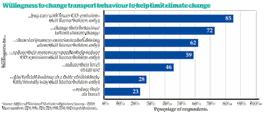 Theft of protected wood in the Petrified Forest National Park in Arizona increased after a notice was put up reading “Your heritage is being vandalised every day by theft losses of petrified wood of 14 tons a year, mostly a small piece at a time”. It fell when it was replaced by one reading “Many past visitors have preserved the environment by not taking away any petrified wood”.
Theft of protected wood in the Petrified Forest National Park in Arizona increased after a notice was put up reading “Your heritage is being vandalised every day by theft losses of petrified wood of 14 tons a year, mostly a small piece at a time”. It fell when it was replaced by one reading “Many past visitors have preserved the environment by not taking away any petrified wood”.
- Identification: People are more inclined to follow a request by someone they like.
- Authority: Advice is more readily accepted from an acknowledged, credible authority. Personal travel plans need convincing ambassadors - in Melbourne, bus drivers were used.
- Scarcity: People respond more to the fear of loss than to gaining a saving. An energy-saving campaign proved much more effective when households were told how much money they would lose by not having insulation, rather than how much they might save. So in travel, one might stress the loss of time to read or work by not taking public transport, or the lost chance of physical activity.
There is an obvious range of ‘push’ factors: making car use more expensive through taxation or road-user charges; reducing parking provision; reallocation of road space away from motor vehicles.
Evidence shows that alternatives to the car have to be economically superior to induce non-users to switch to public transport, which makes it all the more important that externalities are incorporated in the cost of journeys. These kinds of measures are advocated by those who consider the competitive playing field to be biased in favour of unsustainable modes. To implement them, politicians require either a sense of support for them, or the courage of their convictions.
Measures to influence travel behaviour first have to be agreed and then applied consistently over a long period of time. It has taken decades of bike infrastructure development to achieve Copenhagen’s 36% modal share for cycle commuting. The city calculates that the cost of 1km (0.6m) of cycle track is paid off in five years by the health benefits of users getting more exercise.
Human nature is inevitably to the fore here - in terms of the ‘social dilemma’. The consequences for each individual acting in their own interest (called defection) are ‘better’ than the consequences for acting in the interest of the group (called co-operation), regardless of what other group members do. However, all individuals are worse off if they all defect, rather than co-operate.
If this is accepted, one logical conclusion must be that behaviour change in all but the most altruistic members of society requires an element of coercion that can only stem from government policy. But democratic governments are generally timid and behind the curve, and they will remain so until there is a climate of opinion in which politicians no longer see a choice between environmental suicide and political suicide. Achieving that desirable position would require politicians to ignore the siren calls of unsustainable solutions, as well as a public ‘hearts and minds’ campaign with the same success as those for drink-driving laws and restrictions on smoking.
That is a formidable challenge, given the perversity and irrationality of some minds. There are still a few people in denial over climate change, and studies by the Dutch Transport Research Centre (AVV) even observed a negative impact of environmental and economic information that had been designed to encourage pro-environmental travel behaviour. This is the consequence of cognitive dissonance: the car driver, confronted with the knowledge that their actions damage the environment, remains unwilling to change their behaviour and reacts by changing their attitude to dispel the dissonance.
Clearly there is a tipping point at which individual awareness leads to action, and that tipping point will be very different for supporters of the Campaign for Better Transport and for the Association of British Drivers.
Pro-socials and pro-selfs
But what are the determinants for the uncommitted? Behaviourists distinguish between pro-socials who take into account the consequences both for themselves and for society, and pro-selfs who do not. However, for the wider concerns of pro-socials to be maintained, they have to believe that at least a sufficiently large proportion has the same concern for society as they have. Pro-selfs are not affected in the same way - they may even increase their rate of defection, requiring a more dirigiste approach to change their habits.
Those tipping points are likely to fall somewhere on the Nuffield Ladder of Intervention:
- Do nothing
- Provide information
- Enable choice
- Guide choice by changing the default policy
- Guide choice by incentive
- Guide choice by disincentives
- Restrict choice
- Eliminate choice
Consensus on sustainable transport goals can be more fragile. As the first cycle superhighways are being built in London, a minister for roads in New South Wales is busy ripping out a major Sydney cycleway and prioritising cars over active travel, to the fury and dismay of those who recognise its value.
Equally, Boris Johnson’s dismantling of London’s outer congestion charge zone illustrates the difficulty of maintaining progressive measures when a politician places his career before the common good. Today London is Europe’s most congested city, constantly breaching air quality limits. The quest for sustainable travel is never going to be an easy linear progression.
Unsurprisingly, there is greater support for ‘pull’ than ‘push’ measures. In each of the three Sustainable Travel demonstration towns of the 2000s (Darlington, Peterborough and Worcester), people thought that improving facilities for walking, cycling and public transport would be more effective than restricting car use or parking. In the end, there was near unanimous support (between 85% and 94%) for transport policies that support walking, cycling and public transport even if these disadvantage the private car. These attitudes are similar to those held across the UK and the European Union, according to comparable research conducted in the early 1990s.
Among the key lessons learned from such projects are:
- Smarter Choice Programmes are staff-intensive and take planning.
- It is vital to engage with elected members.
- It is valuable to engage with partners.
- Reluctance to implement complementary measures to ‘lock in’ traffic reduction, by preventing development of induced journeys encouraged by better flowing traffic.
- Strong brand needed.
- Wide distribution of information and publicity.
- Innovative campaigns to celebrate sustainable travel.
- Synergies from a broad programme.
- Big wins in car miles/traffic reduction from reducing journeys to work.
- Interventions work best when accompanied by quality improvements (think of Chris Green’s transformation of Network SouthEast).
- High value for money.
Lack of experience with public transport is a considerable barrier to changes in the mobility-mix, which begs the question: should use of public transport and the benefits of active travel be part of school education, accompanied by special offers from transport providers?
We know that active children are healthier, happier and more socially connected than children with a more sedentary lifestyle, but for the rail industry the benefit comes from forming sustainable travel patterns at a young age, which are more likely to be continued into adulthood.
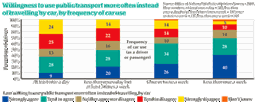 Of course, for many rural journeys, modal choice does not exist. But even accepting that it is impossible to reduce car use everywhere, there are still ways to encourage greater use of sustainable modes in the countryside. At a time of potentially savage cuts to rural bus services, creative alternatives to large buses need to be found.
Of course, for many rural journeys, modal choice does not exist. But even accepting that it is impossible to reduce car use everywhere, there are still ways to encourage greater use of sustainable modes in the countryside. At a time of potentially savage cuts to rural bus services, creative alternatives to large buses need to be found.
Answers are likely to be found in the strength of rural and small town communities, drawing on the same spirit that has made Community Rail Partnerships such a success in revitalising rural lines and stations. Community Rail stations could become hubs for minibus or taxibus services, as well as for the bike hire that some provide, especially those stations serving national parks or other tourist attractions. Many already have thriving cafes.
Plymouth has been at the forefront in developing the idea of the taxibus, where local bus services are provided by Hackney carriages. The circular 223 St Budeaux Taxibus operates in the same way as full-sized buses, picking up and setting down at stops along a route according to a timetable. On some sections they operate on a ‘hail and ride’ basis, where customers will be picked up or set down wherever it is safe to do so. Fares are similar to fares charged by other bus operators in the city.
Prospects for rural community buses could be enhanced by expanding the concept of the Swiss PostBus, which carries passengers, mail and parcels to rural areas. Is there scope for adding delivery of groceries or library books?
As Tom Worsley (visiting fellow in transport policy at the Institute for Transport Studies) suggests: “It would make an interesting experiment for a graduate student to take the logistics packages of an online delivery service and the logistics requirements of a given area, and ask: if we wanted to include passenger transport, what could we achieve and how would passengers react to waits while things are dropped off?
“No one likes services made worse, but something is better than nothing. A local authority could invite bids from companies delivering to local areas, to see which might be interested in earning some extra money.’
Kris Beuret, of Social Research Associates, believes that the cohesion of village communities could allow someone to champion a liftshare scheme, which might reduce the need for car ownership among people who use a car for only a few hours a week. It would also obviate the need for those without a car to move.
He adds: “In the 1960s, Cornwall and Devon had a policy of providing bus services to key villages but not others, and suggested people should move to x, y and z. It was seen as a bit Stalinist at the time but I think it may come back. Many are now asking: why would one move at 55 to somewhere where car use was unavoidable? The reason why so many move to the seaside is not just the air, but good rail links.”
Professor Jillian Anable, of the University of Aberdeen, sees the development of autonomous vehicles as heralding major changes in travel behaviour: “The future will not be about owning cars, but accessing them in conjunction with trains, cycling and walking. The difficulty of mixing autonomous vehicles with pedestrians and cyclists means it’s not going to happen in towns, but it could on motorways within 15 years.”
Beuret agrees: “Many people think that the free movement of individual privately owned vehicles is probably time limited now, and some form of road charging - congestion charging - will come in.”
Levels of car use
However, sales of new cars in the UK have risen for 42 consecutive months since early 2012, with a rise of 6.7% in the year to August 2015. One reason suggested has been the very good deals available for new more economical cars, especially by leasing. In contrast, some transport economists are expecting to see a rise in the number of single-car households, through a combination of economic circumstance coupled with the ‘pull’ factors of public transport.
Looking further ahead, public confidence in autonomous vehicles may be hard to win, given the recall of 1.4 million vehicles by Fiat Chrysler because they could be vulnerable to hackers. It would be one thing having your own car locked by hackers demanding a fee for it to be released, but quite another for autonomous vehicles to be hijacked. John Naughton, in The Guardian, argued cogently that the “notion that mass use of the self-driving car could become a practical reality in the foreseeable seems like the purest hogwash”.
More immediate are such questions as whether young urban professionals will revert to parental levels of car use as they grow older? How might the principles of the Smarter Choice programmes in the three towns be applied to medium- and longer-distance journeys? The DfT has never tried to change inter-urban travel behaviour.
There is an unassailable case for government to influence travel behaviour so that all future increases in transport demand are by less damaging modes. Road investment simply compounds problems by inducing more traffic, and even the US recognises that it is impossible to build your way out of vehicle congestion, despite its greater scope for sprawling land use.
As a paper by UCL’s Transport Studies Unit summarised: “Overall, the conclusion is that policy makers and transport industries have more scope to influence travel behaviour than they think, but only if transport interventions are consistent with each other, maintained over a lengthy period, and supported by analytical methods and appraisal frameworks that are not yet commonplace.”
Read the peer reviews for this feature.
Download the graphs for this feature.
 Peer review: Anthony Smith
Peer review: Anthony Smith
Chief Executive, Transport Focus
Having become Transport Focus as of this spring - when the Department for Transport expanded our remit beyond our previous role of representing the interests of rail, bus, tram and coach passengers - we are rapidly developing our understanding of the needs of users of the Strategic Road Network (SRN) in England… motorways and major A-roads.
It has been interesting to use this new knowledge to compare the priorities for journey improvements for rail passengers and car drivers. While car drivers rank improved road surface quality ahead of anything else, ride quality does not feature in rail passengers’ top 30.
The top priority for rail passengers is better value for money for the price of their ticket, but value for money is not an issue for car drivers. They may think about fuel costs and parking charges, but the true cost of motoring (vehicle costs, insurance, vehicle duty) are largely ignored, although in other research we do see the cost of parking cited as a reason for taking the bus or train into city centres these days.
One common desire is for a more reliable journey experience. Reduced journey times rank fifth and increased reliability seventh for car drivers, while for rail passengers more trains arriving on
time comes out fourth and less frequent major unplanned disruptions sixth.
Sadly ‘green issues’ barely feature in our research among transport users. Better protection of the environment ranks 11th for car drivers, and while rail passengers acknowledge the green credentials of electric trains, they are more impressed by more frequent, reliable services and the more modern, comfortable environment these provide.
Knowledge of the regulatory environment is equally confused among both rail and road users. Drivers do not understand which roads constitute the SRN, nor the responsibilities of Highways England - they do not know whether it is central government, county councils or local authorities who fund and maintain the roads on which they travel. On rail, passengers do not understand the role of government and franchising, nor how Network Rail and the train companies interact, although many do at least identify with their train operator as the one to blame when things go wrong!
Our research has shown that rail passengers have little trust in train companies to deliver a decent service, and that (to a large extent) this is because there is a lack of any real relationship between train companies and their passengers. Rail passengers tend to feel they have little control over their journey, and being ‘in control’ is seen as a major benefit of driving.
We know that rail passengers would rather their train be diverted via a longer, slower route than use a replacement bus. And yet, when we have surveyed those forced to use a bus during planned engineering works, the experience is generally better than they had anticipated. This may be an extreme way of prompting modal switch (and not one the train operators are likely to support), but anecdotal evidence supports the idea that passengers can be forced into long-term changes by a short-term change.
Strikes affecting one mode may provide the motivation to research alternatives, and while the experience of a strike day may be off-putting, the seed may be planted. The long-term disruption of London Bridge, the temporary closure of the tram stop at Manchester Victoria or of specific platforms at Embankment, Tottenham Court Road and the like on London Underground,
may all occasion change that is maintained even after ‘normal service’ is resumed.
It is not in TF’s remit to promote one mode over any other, but we do believe operators must understand travellers’ priorities - and good connection with all forms of public transport is key.
 Peer review: Alex Hynes
Peer review: Alex Hynes
Managing Director, Northern Rail
Anthony highlights that change in personal circumstance is likely to influence travel behaviour. This presents opportunities for the rail industry and transport authorities.
Across the Northern network local authorities have recognised the need for good transport links to serve residential, industrial and leisure developments. In recent years stations have opened at Buckshaw Parkway in Lancashire, serving residential developments, and in the North East, where a station now serves James Cook Hospital and will cater for growth as nearby leisure and residential developments open.
In the case of residential developments we need to work closely with local partners to encourage modal shift from the beginning. As new residents move into their homes, welcome packs could provide information on the range of public transport services available - from rail and bus to other opportunities such as bike hire and car sharing schemes.
We also need to provide the standard of service that will encourage this modal shift. A prime example of where this works well is the routes we serve to the north west of Leeds, carrying passengers from towns such as Ilkley, Guiseley and Skipton. Working with West Yorkshire Combined Authority, we offer a frequent commuter service into Leeds on an electrified railway with the most modern trains in our fleet. It’s one of our most popular services - electrification and the introduction of new trains helped encourage modal shift from road to rail, leading to 70% of commuter traffic on that corridor into Leeds being by train. People don’t want to sit in traffic on congested road arteries - instead they value the time the train journey offers for them to be productive, whether that’s checking emails or catching up with friends.
A new station is due to open soon at Apperley Bridge, serving new residential developments on the route. It is one of three new stations to open in West Yorkshire alone over the next year.
Leeds City Region is the UK’s largest economy outside London, and a good transport network can support this. But with growing economy comes growing expectations. New stations and enhanced infrastructure have their part to play, but the quality of overall service (a comfortable and clean on-train environment, WiFi and charging facilities) will be just as important, as professionals make their decision on how to get to work. We see this clearly on one of our main corridors from Harrogate into Leeds. Here, rail is in competition with bus providers who have raised their game in terms of on-board experience. Journey times are broadly comparable, so customers start to look for added value to aid their decision-making.
Working with combined authorities and other transport planners across our network helps align local bus services (and in some areas light rail services) with train timetables, providing good onward connections. However, despite the best efforts from all involved, this can be inconsistent and some authorities have to make difficult funding decisions - in some rural areas on our network, bus services are being reduced or removed altogether. Perhaps the Swiss PostBus or Plymouth Taxibus models that Anthony mentions could be the answer here.
If punctuality, quality of service and value for money are all positive drivers for using public transport, it is also important that operators consider end-to-end journey factors. This is one of the pieces of work we have been doing as part of setting station standards at Northern Rail. We manage 464 stations, so this is no mean feat!
However, it is important to drive consistency and greater use of our facilities. Our work, in partnership with our stakeholders, is demonstrating that factors such as signage, way finding and cycling facilities are important for our customers. And this stretches beyond the immediate station lease area. For example, we can provide secure cycle storage on the station, but if the route there has no cycle lanes in busy traffic or is poorly lit, it isn’t an attractive option for users.
In summary, operators cannot work in isolation if we are to help drive changes in travel behaviour. Only through offering high-quality, genuinely integrated solutions across all modes can we effect a real shift change. Rather than trying to achieve this change through central government, devolution is an opportunity to drive greater transport integration and encourage modal shift to public transport in the region.
 Peer review: Prof. Paul Salveson MBE
Peer review: Prof. Paul Salveson MBE
Transport analyst
Anthony Lambert is a highly accomplished writer on railways and transport, from both a contemporary and historical perspective. He is also passionate about issues around climate change and the threat it poses to society. This article covers some critically important ground that is of enormous relevance not only to the rail industry, but also to government and other decision-makers.
He makes the point that travel behaviour is shifting - and the shift is towards sustainable transport and away from the car. There are lots of reasons for this, and most (whether we like it or not) are ‘selfish’ ones. Not many people give up their car because it’s pumping pollutants into the atmosphere, but because driving is becoming less and less of an enjoyable - and affordable - experience. Yet there is no doubting the difficulties in achieving modal shift away from cars. Anthony stresses that there is a need for an element of ‘push’ and ‘pull’ - a degree of coercion combined with offering quality and ease of access to more sustainable forms of public transport.
What seems clear is that there are major cultural issues at work here. Train and bike are seen, particularly by younger people, as ‘cool’ while buses aren’t, at least in the UK. We’re seeing a ‘Beeching of the buses’ in many parts of the UK, as local authorities are forced to cut their supported network.
He makes some useful comments about how this could be addressed, using some of the experience of the Community Rail Partnership movement. Could rail provide more of an integrated package, particularly in rural areas where use of any form of public transport is low? My hope is that in the next few years we will see the first steps towards integrated franchises, where rail provides the spine of the network, with feeder bus services that are (in effect) an extension of the rail network.
Anthony suggests that “Community Rail stations could become hubs for minibus or taxibus services, as well as the bike hire some provide, especially those stations serving national parks or other tourist attractions. Many already have thriving cafes.” He goes on to talk about rural bus services providing a small parcels service and the development of lift-sharing.
These are all good ideas but we need to find a way of integrating all these disparate ‘good ideas’ and driving them forward as a mutually-supporting package. The idea of ‘community business units’ which could develop from existing CRPs into viable social enterprises providing a range of services – with the railway at its heart – needs testing in practice.
It need not just be ‘transport’ services either. but include anything which meets a local need and adds value to the core transport operation. This isn’t microfranchising (let’s leave operating the trains to the people who know how to do it), but get the train operator involved as a partner in a community business that can start to reverse not just the decline in public transport use but also the economic problems facing many rural areas.
One final thought. Travel behaviour can change. but that will take political will. Until our (mainly male and ageing) politicians start using buses and trains, change will be slow.

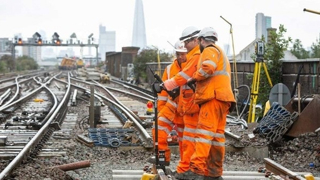
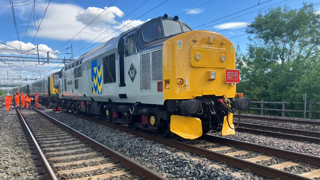

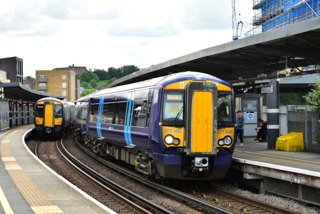
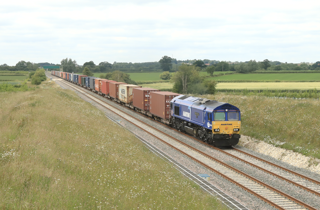










Login to comment
Comments
No comments have been made yet.